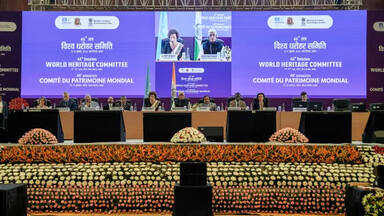Royal Court of Tiébélé
Royal Court of Tiébélé
The property is an earthen architectural complex established since the 16th century that bears testimony to the social organization and cultural values of the Kasena people. Enclosed by a protective compound wall, the Royal Court consists of a set of buildings arranged in distinct concessions separated by walls and passageways leading to ceremonial and gathering places outside the compound. Built by the men of the Royal Court, the huts are then adorned with decorations of symbolic significance by the women, who are the sole guardians of this knowledge and ensure this tradition is kept alive.
Description is available under license CC-BY-SA IGO 3.0
La Cour royale de Tiébélé
Ce bien est un ensemble architectural en terre installé depuis le XVIe siècle et témoignant de l’organisation sociale et des valeurs culturelles du peuple Kasena. Clôturée par un mur d’enceinte défensif, la Cour royale est composée d’un ensemble d’édifices organisés en concessions distinctes et séparés par des murs et des passages les reliant aux lieux de cérémonies ou de rassemblement extérieurs à l’enclos. Construites par les hommes de la Cour royale, les habitations furent ensuite décorées de peintures symboliques réalisées par les femmes, seules détentrices du savoir et chargées de sa transmission.
Description is available under license CC-BY-SA IGO 3.0
البلاط الملكي في تيبيليه
الموقع عبارة عن مجمَّع معماري طيني أُنشئ في القرن السادس عشر، وهو يشهد على التنظيم الاجتماعي والقيم الثقافية لشعب كاسينا. والبلاط الملكي محاط بسور ويتألف من مجموعة من المباني المرتبة ضمن مناطق تفصلها عن بعضها البعض جدران وممرات تقود إلى أماكن مخصصة للاحتفالات والتجمعات خارج المجمَّع. ويضطلع الرجال بمهمة بناء البلاط الملكي ثم تقوم النساء بتزيين الأكواخ بزخارف رمزية، وهنَّ الحارسات الوحيدات لهذه المعارف ويضمنَّ استمرارية هذا التقليد.
source: UNESCO/CPE
Description is available under license CC-BY-SA IGO 3.0
铁贝莱王宫
铁贝莱(Tiébélé)王宫是自16世纪以来建造的土制建筑群,体现了卡塞纳(Kasena)人的社会组织体系和文化价值观。王宫四周围绕着保护性院墙,墙壁和走廊既将内部建筑群分隔为不同区域,又通向围墙外的仪式和聚会场所。王宫由宫中男性建造,随后女性成员为其绘制具有象征意义的元素。女人是相关知识的唯一守护者,她们确保着这一传统的延续。
source: UNESCO/CPE
Description is available under license CC-BY-SA IGO 3.0
Королевский двор Тьебеле
Объект представляет собой глинобитный архитектурный комплекс, созданный в XVI веке и являющийся воплощением социальной организации и культурных ценностей народа касена. Королевский двор обнесен защитной стеной и состоит из нескольких зданий, расположенных в отдельных уступах, разделенных стенами и проходами, ведущими к местам проведения церемоний и собраний за пределами комплекса. Здания комплекса, построенные мужчинами королевского двора, затем украшаются символическими предметами женщинами, которые являются единственными обладательницами этих знаний и следят за сохранением этой традиции.
source: UNESCO/CPE
Description is available under license CC-BY-SA IGO 3.0
La Corte real de Tiébélé
El sitio es un complejo arquitectónico de tierra que se estableció a partir el siglo XVI y que da testimonio de la organización social y los valores culturales del pueblo Kassena. La Corte real está rodeada por un muro de protección y está compuesta por un conjunto de edificios dispuestos en distintas secciones separadas por muros y pasadizos que conducen a lugares ceremoniales y de reunión fuera del recinto. Las chozas son construidas por los hombres de la Corte real y decoradas con adornos que revisten una significación simbólica por las mujeres, que son las únicas guardianas de estos conocimientos que garantizan que esta tradición se mantenga viva.
source: UNESCO/CPE
Description is available under license CC-BY-SA IGO 3.0
Outstanding Universal Value
Brief synthesis
Established since the 16th century at the foot of the hill of Tchébili, 172 km south of the capital Ouagadougou and approximately fifteen kilometres north of the border with Ghana, the Royal Court of Tiébélé is an earthen architectural complex that bears testimony to the social organisation and cultural values of the Kasena people.
Its specific architecture, which combines earth, wood, cow dung and straw, is arranged according to a social and spatial distribution inside the Court based on the status of the inhabitants. A distinction is drawn between the mother houses or Dinian, the foundational structures of the domain, with a figure-of-eight floor plan, reserved for the elderly, widows, unmarried women and children; the houses of the young married people, which are quadrangular (Mangolo); and the houses of the adolescent and unmarried men, which are circular (Draa).
In addition to the houses, there are symbolic sacred elements: the pourou, the sacred tumulus where the placenta of the new-borns of the royal family are buried; the red fig tree marking the entrance to the Court, beneath which are placed the sacred stones (dala), on which sit the princes and dignitaries; the nabari, the tomb of the founder of the royal family; the nankongo, which is used as a law court and place of parley; and the bonnalè, the cemetery of the Royal Court. These elements bear eloquent testimony to the preservation of traditional practices specific to Kasena culture.
The Court is also the embodiment of practices and knowhow which help to make it an evolving and living site. The practice of mural decoration, exclusively reserved to the women of the Court, is subject to a repertory of motifs that are both ancient and constantly renewed, and passed on from generation to generation by observation and practice, and by the organisation of ceremonies and competitions. The ritual practices that are fundamental to the ancestor cult and the funeral rites are an integral part of the spiritual and temporal rituals that are specific to Kasena culture, under the authority of the Pê.
Criterion (iii): The Royal Court of Tiébélé is an outstanding example of an earthen architectural complex, which is distinctive in terms of its construction techniques, its spatial, social and functional distribution, the role of men and women in its construction, the plurality of its architectural forms, its decorative style and its specificity as a living site. It is an outstanding illustration of Kasena culture, of which the Royal Court architecture and mural decorations are representative, and of the associated social, anthropological and political aspects. These characteristics bear outstanding and living testimony to the culture and traditions of the Kasena people, which have evolved over time while preserving the identity and values of the Kasena people.
Integrity
The integrity of the Royal Court of Tiébélé is based on the set of concession huts and on the sacred symbolic elements that continue to be used today. The Royal Court has retained its original site and has been preserved from urban development up to the present day by its immediate surroundings, which are still predominantly natural. The property embodies all the attributes of Outstanding Universal Value. However, integrity continues to be threatened by a lack of maintenance, or even the ruin of certain concessions, and the use of new materials and chemicals. Furthermore, the maintenance of the concessions and their alterations lead sometimes to construction malpractices that cause problems of rising damp, erosion and water drainage. Lastly, hut construction techniques are changing, particularly with the use of the adobe technique, the making of cement brick foundations and the use of tar-based paint coatings; if these practices become widespread, they could adversely affect the integrity of the property.
Authenticity
The Royal Court of Tiébélé has successfully preserved its authenticity with regards to the conservation or evolution of traditional practices, both as concerns construction methods and the architecture that is specific to the Kasena culture and way of life, which includes the social distribution of tasks of construction and decoration. It is however important to put in place a system that ensures the preservation of ancient motifs, while enabling evolution through the creation of new motifs, thereby strengthening the living character of the property and of the practices and knowhow associated with its architecture. The development of the use of new materials, such as cement, corrugated sheet metal, metal windows and tar and other chemicals to replace the natural pigments used for the mural decorations, could adversely affect the authenticity of the property.
Protection and management requirements
The Royal Court of Tiébélé is under the administrative supervision of the General Directorate of Culture and Art. The Court is legally protected by the Law 024-2007/AN of 13 November 2007 for the protection of the cultural heritage of Burkina Faso and Decree n°2014-1019/PRES/PM/MCT/MEDD/MATS/MATDS of 28 October 2014 for the classification of cultural and natural properties and their inscription on the Tentative List of the heritage of Burkina Faso. Law n°014/96/ADP of 23 May 1996 for agricultural and land reorganisation in Burkina Faso (RAF) allows the community to dispose of its domain, that is the whole of the Court and a large proportion of the buffer zone, which is a property owned by the Pê. The intangible dimension of the Court is taken into account by the Order n°2015-0338/MCT/SG of 23 December 2015 for the proclamation of the Living Human Treasures of Burkina Faso. The management of the Royal Court of Tiébélé is traditionally the task of the Pê (the customary Chief) and of the community.
A conservation and management plan for 2022-2026 was validated in 2021. Two bodies have been set up to implement the plan: a local committee responsible for implementing the plan through conservation actions for the property, and a scientific committee whose task is to carry out specific studies of the property.
The protection and management plan will be strengthened by the incorporation in the management and conservation plan of the existence and potential impacts of land use and development projects that are ongoing or that may arise in the future, the recourse to Heritage Impact Assessments, risk management and monitoring of the implementation of the conservation plan, while defining the roles, responsibilities and modes of operation of the local committee and the scientific committee.


